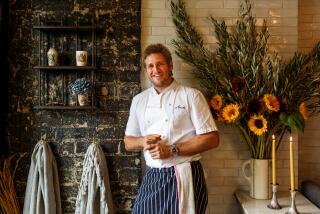The secret to prizewinning apple pie

- Share via
The holidays had an accent at our house. My mother, an inspired cook, filtered American tradition through her French sensibility. It’s there in the photos of our first few years in the States — a crisp-skinned goose on the Thanksgiving table, and at Christmas, a bubbling cassoulet. As the seasons passed, American idiom crept into our kitchen. My mother experimented, learned to roast a turkey, to make cranberry sauce, to melt marshmallows on the yams.
It was to this more assimilated holiday table that I first brought that most American of icons — a homemade apple pie. Sliced and served with the other desserts, a pumpkin tart and a tart Tatin (assimilation, it seems, only goes so far), it vanished from everyone’s plates.
That recipe was on my mind when some friends and I decided to compete in the Malibu Pie Festival a few years ago. I’d made it many times over the years, always with varying results. At its best it turned out great, firm and fruity with a flakey crust. At its worst, you’d cut the first slice to find a soggy, soupy mess. With the pie contest looming, it was time for a new approach. Time, it turned out, to break a few rules.
A better filling
First up was a look at the ingredients themselves. Never a fan of supermarket Granny Smiths, freakishly large and largely soulless, I sampled my way through the Santa Monica farmers market to the See Canyon fruit stand. This seller is the Holy Grail of great apples.
With flavor bombs like Baldwin, Spy Gold, Stayman Winesap, Enterprise, Pippin and Spitzenberg, you just need a few pounds of a few varieties and you’ve got the underpinnings of a fantastic pie.
But what to do with the fruit? Recipes invariably tell you to slice your apples thinly, then toss them in a bowl with sugar and spices. That’s the fun part, really, all that stirring as the sugar and the fruit create a kind of slurry, as the nutmeg and cinnamon spread in flecks through the mixture, filling the kitchen with their sweet scent. But it always bothered me that the instant the sugar goes in, the juice starts to leave the apples. By the time you’re spooning the filling into the crust, you’re awash in liquid. And while most recipes compensate with the addition of corn starch or even flour, I’ve always disliked the way thickeners blunted the apples’ bright flavor.
It was food writer John Thorne who offered another way. His apple pie recipe flouts the slice-it-thin rule and urges you to cut your fruit into nice, big chunks. I didn’t even bother to core the apples — just sliced off each side, then made eight sort-of-equal slabs. This sharply reduced the surface area of the apples that could come into contact with the sugar, thus reducing the amount of liquid that would leak into the pie.
The final moment of mutiny came, oddly enough, via a technique I saw Martha Stewart demonstrate on TV. Instead of doing the mixing bowl thing with the apples and sugar, she piled her sliced fruit directly into the crust. Only then did she sprinkle the sugar on top, assuring her viewers that the sweeteners and spices would disperse during the baking process.
On to the crust
I know there are people who have perfectly good luck making pie crust in a food processor. I am not one of them. It’s too easy to blend the butter and flour too long, which means the fat globules get too small. They coat the flour and give you a waterproof mixture, which yields a tough and ugly crust. It’s just as easy — and a lot more fun — to use a pastry cutter to get the right proportions, to achieve those small pebbles of butter that give a flakey crust.
What put my pie crust over the top, though, was a technique borrowed from Rose Levy Berenbaum, author of “The Pie and Pastry Bible.” You cut the fat into tiny cubes (she suggests three-quarters inch, but I go a bit smaller), then add it to a plastic bag with the flour mixture. Toss to distribute, squeeze out the excess air and — here’s the genius part — you go over the whole thing with a rolling pin.
The butter (or leaf lard, if that flavor appeals to you) flattens out into golden flakes. Chill the flattened mixture in the fridge for half an hour, then bring it out and quickly add the water, stirring it until it forms a dough. Form a disk, chill again to make sure the butter is good and firm, and your crust is ready for the rolling pin.
The new approach in place, I went to work. Made a crust, mounded apple chunks into the pan, stirred the spices into the white sugar and sprinkled the mixture over the apples, added an equal amount of brown sugar, rolled and crimped the top crust, then prayed to the pastry gods as everything baked.
Four hours later, I was in shock, holding the blue ribbon for the best apple pie at the Malibu Pie Festival. And after second- and third-place finishes the next two years (pie crust issues, since resolved), my rebel apple pie once again won the grand prize at this year’s pie contest.
This is the apple pie I bake every time now, and it never fails. Cut it open, and it’s all about the fruit, generous hunks of gently baked apple, its pure, clean flavor enhanced by a sweet, spicy glaze. It’s the pie that will make an appearance at my holiday table, along with the cheese plate, some roasted figs and my mother’s walnut tart.
More to Read
Eat your way across L.A.
Get our weekly Tasting Notes newsletter for reviews, news and more.
You may occasionally receive promotional content from the Los Angeles Times.









